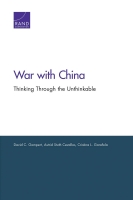 Summary
Summary
Premeditated war between the United States and China is very unlikely, but the danger that a mishandled crisis could trigger hostilities cannot be ignored. Thus, while neither state wants war, both states’ militaries have plans to fight one. As Chinese anti-access and area-denial (A2AD) capabilities improve, the United States can no longer be so certain that war would follow its plan and lead to decisive victory. This analysis illuminates various paths a war with China could take and their possible consequences.
Technological advances in the ability to target opposing forces are creating conditions of conventional counterforce, whereby each side has the means to strike and degrade the other’s forces and, therefore, an incentive to do so promptly, if not first. This implies fierce early exchanges, with steep military losses on both sides, until one gains control. At present, Chinese losses would greatly exceed U.S. losses, and the gap would only grow as fighting persisted. But, by 2025, that gap could be much smaller. Even then, however, China could not be confident of gaining military advantage, which suggests the possibility of a prolonged and destructive, yet inconclusive, war. In that event, nonmilitary factors — economic costs, internal political effects, and international reactions — could become more important.
Political leaders on both sides could limit the severity of war by ordering their respective militaries to refrain from swift and massive conventional counterforce attacks. The resulting restricted, sporadic fighting could substantially reduce military losses and economic harm. This possibility underscores the importance of firm civilian control over wartime decisionmaking and of communication between capitals. At the same time, the United States can prepare for a long and severe war by reducing its vulnerability to Chinese A2AD forces and developing plans to ensure that economic and international consequences would work to its advantage.
PDF
Skip to content
